
Cephalus and Aurora is the title of two oil paintings by Nicolas Poussin, both dated to about 1629 or 1630. [1] The first is in the National Gallery, London; the second belongs to the Worsley baronets, of Hovingham Hall, Yorkshire.

Cephalus and Aurora is the title of two oil paintings by Nicolas Poussin, both dated to about 1629 or 1630. [1] The first is in the National Gallery, London; the second belongs to the Worsley baronets, of Hovingham Hall, Yorkshire.
Aurora, the lovely precursor of morning, who "opens with her rosy fingers the gates of the east", is seen seated on a bank on the confines of a grove, with her arms round the waist of her beloved Cephalus: this tender restraint on his departure, is seconded by a sweet smile beaming in her upraised countenance; but although he feels the gentle pressure, and makes no effort to escape from it, he dares not trust his eyes to behold her charms, but turns to gaze on the portrait of his absent Procris, held to his view by the young god of love. [lower-alpha 1] A second cupid is behind Aurora, unveiling her charms, so that her only covering is a white vesture round her loins.

On the opposite side of the picture is a river deity, [lower-alpha 2] reclining asleep on a streaming vase gently flowing rivulets which water the earth; beyond him stands a winged white horse, styled by some writers Pegasus, attached to a car, but the latter is nearly concealed by trees; still more remote is seen a naiade recumbent on a bank, apparently just rising from her dewy couch, and beholding in the eastern hemisphere, "Phoebus urging onward his fiery coursers and launching his streams of light through the dewy moisture of the morning"; a signal for the Thessalian prince to commence his rural sports. [4] [5]
Engraved in the National Gallery by William Holl the Younger. [6] [7] [8]
Smith (1837) comments, "This elegant classical allegory is here exemplified by the pencil of Poussin with the genius both of a poet and painter." [6]

The composition is described at length by Bellori. [3]
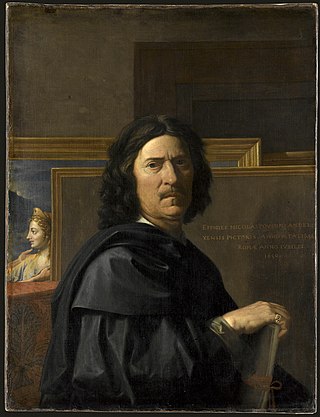
Nicolas Poussin was a French painter who was a leading painter of the classical French Baroque style, although he spent most of his working life in Rome. Most of his works were on religious and mythological subjects painted for a small group of Italian and French collectors. He returned to Paris for a brief period to serve as First Painter to the King under Louis XIII and Cardinal Richelieu, but soon returned to Rome and resumed his more traditional themes. In his later years he gave growing prominence to the landscape in his paintings. His work is characterized by clarity, logic, and order, and favors line over color. Until the 20th century he remained a major inspiration for such classically-oriented artists as Jacques-Louis David, Jean-Auguste-Dominique Ingres and Paul Cézanne.

Andrea Sacchi was an Italian painter of High Baroque Classicism, active in Rome. A generation of artists who shared his style of art include the painters Nicolas Poussin and Giovanni Battista Passeri, the sculptors Alessandro Algardi and François Duquesnoy, and the contemporary biographer Giovanni Bellori.

The Loves of the Gods is a monumental fresco cycle, completed by the Bolognese artist Annibale Carracci and his studio, in the Farnese Gallery which is located in the west wing of the Palazzo Farnese, now the French Embassy, in Rome. The frescoes were greatly admired at the time, and were later considered to reflect a significant change in painting style away from sixteenth century Mannerism in anticipation of the development of Baroque and Classicism in Rome during the seventeenth century.

Saint Jerome Writing, also called Saint Jerome in His Study or simply Saint Jerome, is an oil painting by Italian painter Caravaggio. Generally dated to 1605–06, the painting is located in the Galleria Borghese in Rome.

A Dance to the Music of Time is a painting by Nicolas Poussin in the Wallace Collection in London. It was painted between c. 1634 and 1636 as a commission for Giulio Rospigliosi, who according to Gian Pietro Bellori dictated its detailed iconography. The identity of the figures remains uncertain, with differing accounts.

The Lives of the Modern Painters, Sculptors, and Architects or Le vite de' pittori, scultori et architetti moderni is a series of artist biographies written by Gian Pietro Bellori (1613–96), whom Julius von Schlosser called "the most important historiographer of art not only of Rome, but all Italy, even of Europe, in the seventeenth century". It is one of the foundational texts of the history and criticism of European art.
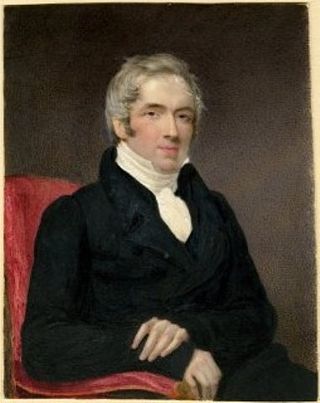
John Smith (1781–1855) was a 19th-century British art dealer who developed the concept of the catalogue raisonné.
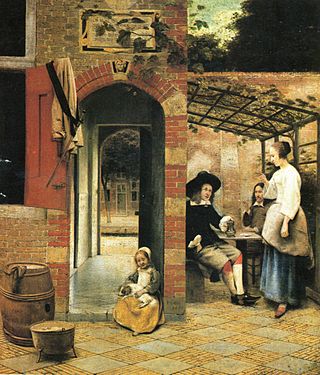
Courtyard with an Arbour (1658–1660) is an oil-on-canvas painting by the Dutch painter Pieter de Hooch; it is now in a private collection. It was sold in 1992 for almost seven million dollars.

The Adoration of the Shepherds is a painting of 1633–34 by the French painter Nicolas Poussin (1594–1665), now in the National Gallery, London. It is in oils on canvas, and measures 97.2 by 74 centimetres. Unusually for Poussin, it is signed "N. Pusin.fe" ["fecit"] on the stone at lower right. By 1637, soon after it was painted, it was owned by Cardinal Gian Carlo de' Medici (1611–1663), the second son of Grand Duke Cosimo II of Tuscany and was placed in his villa outside Florence.
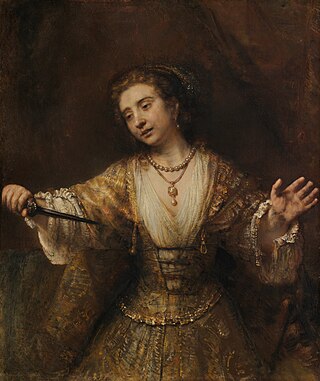
Lucretia is a 1664 history painting of Roman noblewoman Lucretia, historically attributed to the Dutch Golden Age painter Rembrandt in the collection of the National Gallery of Art. In 2015, Ernst van de Wetering of the Rembrandt Research Project said that "the formal properties and execution of [this] painting, I am convinced, exclude the possibility that it could be an autograph work by Rembrandt", and that the painting recalls Aert de Gelder. The painting is not included in the project's 2015 Rembrandt corpus.

Danaë was a 1600-1605 oil on canvas painting by Annibale Carraci, destroyed during World War II. An autograph preparatory study survives in the Royal Collection at Windsor Castle.
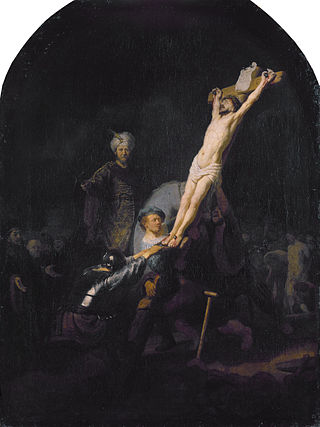
Raising of the Cross is a 1633 painting by the Dutch Golden Age painter Rembrandt in the collection of the Alte Pinakothek. It was painted as part of a "passion" series commissioned in 1633 by Frederick Henry, Prince of Orange. Together with its pendant, The Descent from the Cross, it is one of the rare paintings by Rembrandt with a continuous provenance from the date of completion to today.
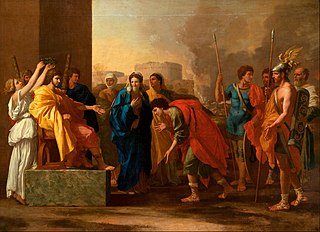
The Continence of Scipio is a 1640 oil on canvas painting by Nicolas Poussin, commissioned by Abbé Gian Maria Roscioli, secretary to Pope Urban VIII. It changed owners several times, reaching the Walpole collection in the first half of the 18th century, from which it was bought for the Hermitage Museum by Catherine the Great in 1779. It was reassigned to the Pushkin Museum in 1930, where it remains. The painting is based on the historical continence of Scipio.

The legendary rape of the Sabine women is the subject of two oil paintings by Nicolas Poussin. The first version was painted in Rome about 1634 or 1635 and is now in the Metropolitan Museum of Art in New York City, catalogued as The Abduction of the Sabine Women. The second, painted in 1637 or 1638, is in the Louvre in Paris, catalogued as L'enlèvement des Sabines.
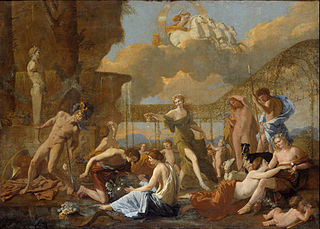
The Empire of Flora is an oil painting by Nicolas Poussin, dated to about 1630 or 1631, which is now in the Gemäldegalerie Alte Meister in Dresden.
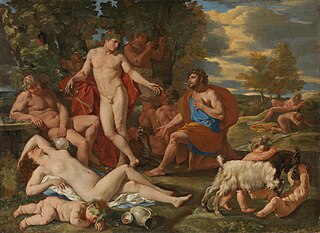
Midas and Bacchus is an oil painting usually attributed to Nicolas Poussin and dated to about 1624–1629, which is now in the Alte Pinakothek, Munich.
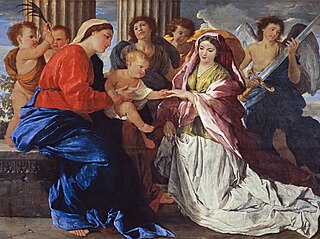
The Mystic Marriage of Saint Catherine is an oil on panel painting by Nicolas Poussin, dated to about 1628–1629, which depicts the mystical marriage of Saint Catherine to Christ. The picture is now in the Scottish National Gallery, Edinburgh.

A Bacchanalian Revel Before a Term is an oil painting by Nicolas Poussin, dated to 1632–1633, which is now in the National Gallery in London.
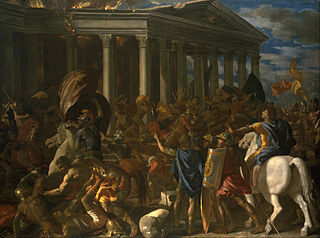
The capture of Jerusalem by Titus in AD 70 is the subject of several history paintings by Nicolas Poussin. The earliest version, dated to 1626, is in the Israel Museum, catalogued as The Destruction and Sack of the Temple of Jerusalem. Another version, dated to 1635, is in the Kunsthistorisches Museum in Vienna, catalogued as Destruction of the Temple in Jerusalem by Titus.